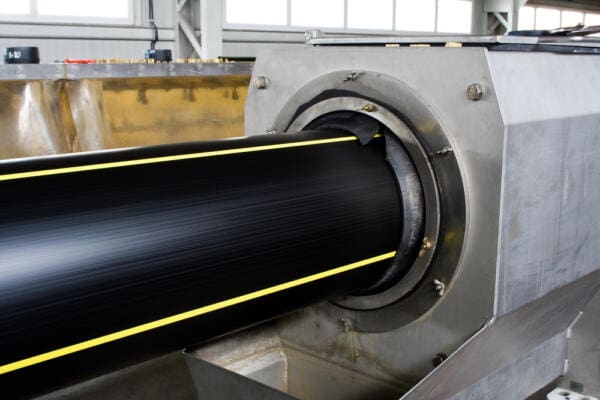
Getting Critical on Extrusion
The extruding of thermoplastics can be complicated and unpredictable, and full consideration needs to be given to the intended product before considering how to set up the production line. Mike Newey, part of the Plastics Consultancy Network, explains.
The extruder is only part of a line of equipment in the production process. It is vital that it is specified correctly to produce the final product in the material of choice at the required production rate. What feeds the material and what follows the extruder for forming, calibration, dimensional control and handling of the final product is of equal importance.
The type of raw material to be used to make the product influences the following: Rheological characteristics for the material; drying the material (if required) before processing; conveying the material to the extruder; screw and barrel design; die design; forming, calibration and cooling requirements; dimensional tolerance control; take off and haul off requirements; cutting to length or coiling; discharge and product handling.
The extruder
The specifying process starts with the final product. Once this is determined, the complete line can be designed. The physical weight per meter of the product will, to a certain extent, determine the size of the extruder required but it is not as simple as saying that we want to produce at, say, 500kgs per hour. An extruder can be specified to do this, but it may not be possible to form, calibrate and cool the final product at this rate, so the extruder cannot be specified in isolation to the rest of the process.
The raw material to be processed will influence the design of the extruder, for example, how the screw flight and compression ratio is designed and how long is the barrel. This is expressed as a ratio of the length to diameter of the processing screw. The compression ratio determines how much shear heating and work is put into the material to produce a homogenous melt. Certain materials need longer screws and barrels to increase the residence time in the extruder to give longer for heating and plasticising or to increase the production rate. Different materials need higher compression and shear rates to enable them to be processed consistently. This is a time/temperature relationship within the screw and barrel of the extruder. Other materials need shorter screws and barrels and lower compression rates to reduce the possibility of thermal degradation during processing. The most common type of extruder is a single screw machine but some thermoplastics process better on twin screw machines that can have either parallel or conical screws.
Some materials process better on a machine with a vacuum vent situated on the barrel to remove volatiles and small amounts of moisture in the material. Thermoplastic materials process at different temperature requirements, from as low as 100°C up to 400°C+ for some engineering thermoplastics. This temperature determines the type of heaters required, particularly for the tooling to be fitted to the extruder. Higher temperature requirements will require more robust and more expensive heaters.
The raw material
Thermoplastic materials come in various forms such as pellets, powders or flakes. Each form has its own handling requirements. Pellets, for example, are easily vacuumed, conveyed either to a drier and then from the drier to the extruder. Pellets are also free-flowing and do not present inconsistent feed problems, whereas powder does present conveying problems, requiring purpose-built systems. Non-free flowing powders do clog and bridge in the hopper and feed units, so purpose-designed agitating devices are required to maintain a consistent feed to the extruder screw. Some lightweight recycled materials in flake form also present particular feeding problems and may need cramming devices at the feed throat of the extruder to maintain a consistent feed to the screw.
Some raw materials can be manufactured with a range of viscosities. For example, a material designed for injection moulding usually would be of low viscosity in its melt stage. A material for extrusion is typically required to be a higher viscosity, but both can be the same generic type of material. Some materials are also hygroscopic and will absorb moisture if exposed to the atmosphere. The effect of moisture in the melt will reduce the viscosity and cause surface imperfections, size variations and generally cause processing problems. These materials need to be dried before feeding to the extruder. Drying should normally be done on a continuous basis through a temperature-controlled dehumidifier. Many materials such as Polyamides will absorb moisture very quickly so should be fed on a closed-loop system from the dehumidifier to the feed throat of the extruder.
Die design
The die forms the melt shape of the product but does not calibrate size or set the final shape. This is done by formers or calibrators that are cooled following their emergence from the die. The design criterion is different for each raw material, for example, drawdown ratios, material swell factors, die land lengths and for profiles where thick and thin parts meet, the flow channels need to be designed to flow evenly out of the lips of the die. A single die will not produce the same result if run with different materials.
Forming, calibration and cooling requirements
The final product design, the raw material and the rate of production will determine the type of forming and calibration requirements. For example, pipe production is done with a wet vacuum calibration system with a sizing collet submerged in a cold water vacuum tank. The rate of production is determined by the rate at which the pipe can be cooled. A thicker wall will require more length of cooling and usually a longer length of vacuum calibration. The pipe can only be cooled from the outer surface as no water or cooling medium can be present in the centre of the pipe. The same also goes for extruded profiles with closed internal cavities.
Certain engineering thermoplastics need water or oil heated formers or calibrators to slow down the rate of cooling. This enables the physical properties to develop to full potential. Shock cooling can degrade these properties and for example, create brittleness in the final product. Other products and materials may be better with air-cooled calibration. Sheet production is normally carried out through chilled or heated rolls to smooth the surface and set the thickness of the sheet. The product should be below its heat distortion temperature by the time it leaves any of the above types of calibration systems. Further cooling may take place after this.
Products made with flexible materials such as window seals may not require any specific calibration and can be run straight into a water bath.
Dimensional control
Dimensional control is a function of the extruder delivering an accurate rate of melt to the calibration system, the cooling rate of the extrudate and the rate it is drawn off. If vacuum calibration is used, this will control critical dimensions, provided all parts of the production line are synchronised. Very precise tolerance control can be achieved by employing laser or ultrasonic measuring equipment. This would be linked either to the extruder speed or the haul-off speed and will feedback in a closed-loop system to maintain very accurate tolerance control by speeding up or slowing down either the extruder or the haul-off device to smooth out process variations.
Take-off/haul off device
The product needs to be drawn off at a very constant rate and synchronised with the extruder and calibration system. The haul-off device can be as simple as a pair of nip rollers synchronised with the extruder and roll stack if film or sheet is being produced. Large pipe production is usually done with a multi belt caterpillar type haul off whereas profile extrusion is usually done with a two belt caterpillar haul off.
Cutting to length or coiling
As the product emerges from the haul-off system, consideration must be given to how the finished product is handled. For example, is it to be cut in straight lengths or is it to be coiled? Production of straight lengths such as pipes are usually cut by using a circular saw mounted on a moving carriage that moves in synchronisation with the haul-off speed.
Extruded profiles can also be cut in the same way. The size of the pipe or profile determines the cutting method. For example, very large pipes are cut using a planetary saw that moves in synchronisation with the haul off. Line speed plays a major part in the cutting method used. For example, very high lines speeds could rule out the use of moving carriages, but guillotine cutting could be used. The physical size of the product will influence if this is feasible.
If the product is flexible, it may be coiled like wire cables. The coiling equipment can be designed to coil automatically for small or large coils. The line speed or production rate will influence how the coiling equipment is designed and built. Very high-speed production will need special consideration for cutting and changing over at the end of each coil.
Product handling
As the product is produced, whether it is cut lengths, coils, sheets or film, consideration needs to be given to how the line operator will handle the finished product. Will the product or batch of products be too heavy for the operator to lift or will special lifting equipment be required? The speed of moving this product away from the extrusion line discharge is critical and needs to at least match the speed of production.
General line requirements
Most extrusion lines need a recirculating water system with a water chiller built into the line. The extrusion process works on heat that must be taken away for the process to work over long periods. Ancillary equipment such as saw and haul-offs need compressed air. These can be set up to service a number of extrusion lines.
There are many other factors to be considered, such as co-extrusion or multi-layer extrusion, where a number of extruders are fed into one die to produce a product made from a number of different materials. Material compatibility needs to be considered along with the die and calibration design.
With volume production, it is possible to set up other operations. For example, operations such as printing, punching, drilling, laminating decorative foils and applying adhesive tapes can be carried out on-line.
Compounding extruders
Plastic formulations are produced by mixing and blending polymers and additives in a melted state. The types of additives are usually added to enhance the properties of the resulting formulation – additives such as UV-stabilisers, anti-oxidants, lubricants, process aides. Strengthening components can be added, such as glass fibre or calcium carbonate fillers to extend and cheapen the formulation. Adding colour pigments or producing a concentrated masterbatch that is later diluted into another material is usually produced by compounding. Other value-adding components can be added, such as anti-microbial additives, conductive additives, fire retardants and many others. Many recycled materials can be added into a formulation, or they can be compounded as the base polymer and additives added to modify and enhance their properties, making them useful for other products.
A compounding extruder is typically a twin-screw machine with a longer barrel than an extruder, designed to extrude a semi-finished or finished product from a plastic formulation that has already been compounded. The extra length is to allow more time to melt the materials being mixed and also to allow for side feeding extruders feeding other additives directly into the melt stream in the compounding screws. Formulations can be mixed with multi-components in a high-speed mixer and discharged as a powder that is then fed to the compounding extruder.
If a standard material formulation is required in a number of colours, the colour concentrates will be added during the compounding operation by either dosing at the feed throat of the compounder or by a side feeding extruder extruding into the melt stream.
Screw designs usually are segmented so that the configuration can be changed to suit the material formulation being compounded. The mixing elements can be a combination of low shear, high shear and mixing sections. The dosing feeders feeding the compounder and side feeders are normally gravimetric or volumetric devices to accurately dose at a predetermined addition rate as determined by the formulation.
Many materials and additives are non-free-flowing powders that will clog and bridge in the hopper and feed units, so purpose-designed agitating devices are required to maintain a consistent feed to the compounding extruder screw. The compounder will have a die on the discharge that produces strands that are then cooled and then chopped up into pellets.
Expert help
This article is not an attempt to cover every possible aspect of setting up an extrusion line. It intends to highlight some of the critical areas and to show that to set up an efficient line to produce a good quality product consistently, needs expert consideration and planning. The capital expense of getting it wrong and the time lost to get the product to market can be immense.
Expert help should be sought.
This article was written by Mike Newey of Mike Newey Consultancy Services, part of the Plastics Consultancy Network (PCN).
Plastics Consultancy Network
Website
Contact






